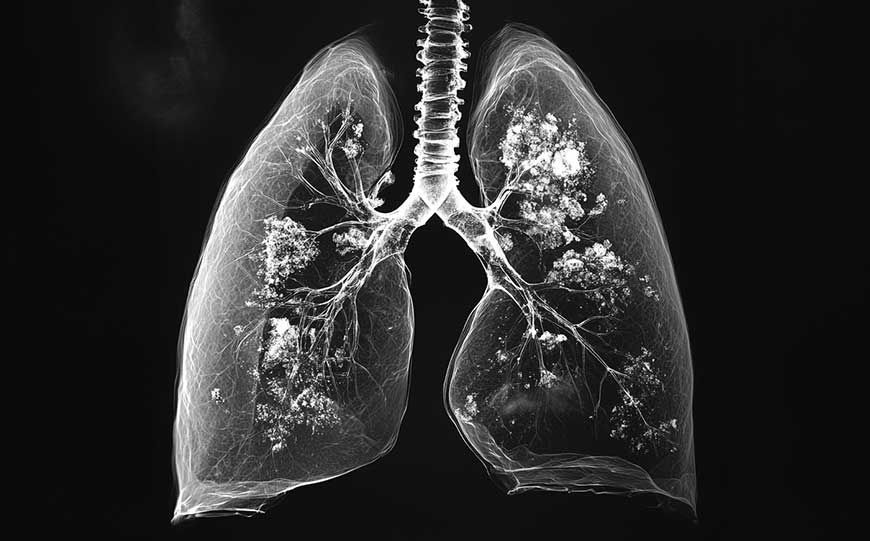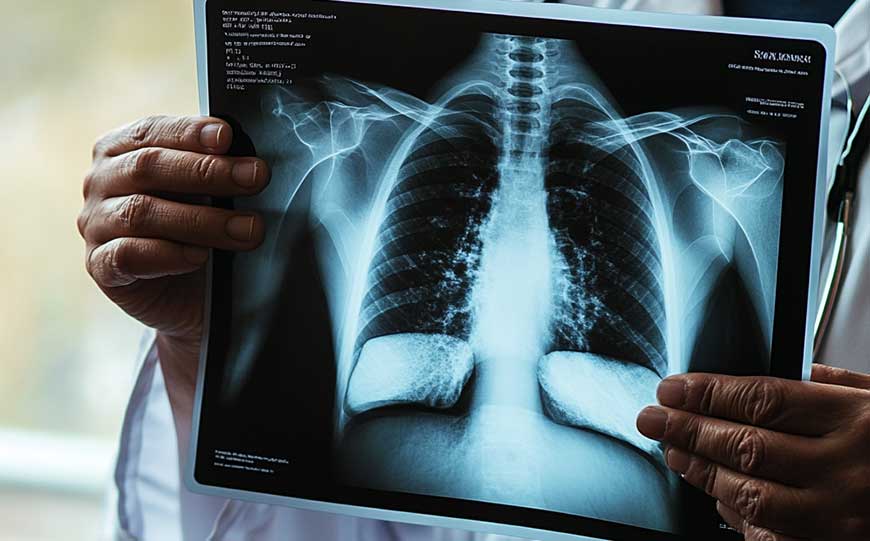
Asbestos is a mineral once widely used in construction and manufacturing due to its fire-resistant properties.
However, prolonged exposure to asbestos fibres can lead to serious health issues, including asbestosis.
But what is asbestosis and what are the common asbestosis symptoms?
Asbestosis is a chronic lung disease caused by inhaling asbestos fibres, leading to lung tissue scarring and severe respiratory problems.
Recognising common asbestosis symptoms early is crucial for effective management.
This article will explore ten common symptoms of asbestosis, helping you understand and identify the signs of this debilitating condition.
Early detection and awareness are key to managing the impact of asbestosis on your health.
Table of Contents
What is Asbestosis

Asbestos exposure can be incredibly harmful, with one of the main dangers being asbestosis.
Asbestosis is a chronic lung disease characterised by the scarring of lung tissue.
This scarring, known as fibrosis, leads to long-term respiratory problems.
The condition is caused by inhaling asbestos fibres, which are tiny, durable, and fire-resistant mineral particles.
Once these fibres enter the lungs, they become lodged in the lung tissue, causing inflammation and scarring over time.
The lung tissue thickens and stiffens, making it difficult to breathe and reducing the oxygen supply to the bloodstream.
Asbestosis is a progressive disease, meaning it worsens over time, and there is currently no cure for it.
What Causes Asbestosis?

The primary cause of asbestosis is prolonged exposure to asbestos fibres.
Asbestos was commonly used in various industries due to its heat-resistant and insulating properties.
When asbestos-containing materials are disturbed, asbestos fibres are released into the air.
Inhalation of these microscopic fibres leads to their accumulation in the lungs.
Over time, the body’s immune response attempts to eliminate the fibres, but this process results in persistent inflammation and damage to lung tissue.
Asbestosis typically develops many years after the initial exposure, often between 10 to 40 years later.
Symptoms gradually appear as the lung damage progresses, making early detection and intervention challenging.
Understanding the causes and risks associated with asbestosis is crucial for preventing exposure and protecting respiratory health.
Who is at Risk of Asbestosis?

Individuals most at risk of developing asbestosis are those who have experienced prolonged and intense exposure to asbestos fibres.
Due to the dangers of asbestos, the risk is particularly high among workers in certain industries where asbestos was widely used.
These include construction, shipbuilding, manufacturing, and mining.
Construction workers, especially those involved in demolishing or renovating old buildings, are at significant risk due to the potential disturbance of asbestos-containing materials.
Shipyard workers and those involved in the production of asbestos-containing products, such as insulation, roofing materials, and brake pads, also face heightened risk.
Additionally, electricians, plumbers, and HVAC workers may encounter asbestos during the course of their work in older structures.
Secondary exposure is another risk factor.
Family members of workers exposed to asbestos can be at risk through fibres brought home on clothing, skin, and tools.
This secondary exposure, while generally less intense, can still lead to the development of asbestosis and other asbestos-related diseases.
Even people living near asbestos mining areas or near facilities that handle asbestos materials can be at risk due to environmental exposure.
Awareness and preventive measures are crucial for those at risk to minimise asbestos exposure and reduce the likelihood of developing asbestosis.
10 Common Types of Asbestosis Symptoms

10 of the most common types of asbestosis symptoms are:
Shortness of Breath
Shortness of breath is one of the earliest and most common symptoms of asbestosis.
It often starts as mild difficulty in breathing during physical activities but can progress to severe breathlessness, even at rest.
This occurs because the scarring in the lungs makes it difficult for them to expand and contract properly, reducing the overall lung capacity and oxygen intake.
Persistent Cough
A persistent cough is another hallmark symptom of asbestosis.
This cough is usually dry and non-productive, meaning it does not bring up mucus or phlegm.
The cough results from the irritation and inflammation of the airways caused by the asbestos fibres embedded in the lung tissue.
This symptom can be particularly bothersome and may not respond to typical cough treatments.
Wheezing
Wheezing, characterised by a high-pitched whistling sound when breathing, is common in individuals with asbestosis.
It occurs because the airways become narrowed due to lung damage and scarring.
Wheezing is often more noticeable during exhalation and can be accompanied by shortness of breath and coughing.
Chest Crackling When Breathing
Chest crackling, also known as rales, can be heard with a stethoscope during a physical examination.
These crackling sounds occur as air passes through the scarred and stiffened lung tissues.
The presence of these sounds indicates the extent of lung fibrosis and is a key diagnostic feature of asbestosis.
Chest Tightness
Chest tightness feels like a constricting or squeezing sensation in the chest.
This symptom is often associated with difficulty breathing and can be uncomfortable or even painful.
Chest tightness in asbestosis is due to the reduced flexibility of the lung tissues caused by scarring.
Chest Pain
Chest pain in asbestosis can range from mild to severe and is often exacerbated by coughing or deep breathing.
The pain results from inflammation and pressure within the lungs due to the buildup of scar tissue.
This symptom can significantly impact a person’s quality of life and ability to perform daily activities.
Shoulder Pain
Shoulder pain can sometimes occur as a referred pain from the lungs.
This happens because the nerves in the chest and shoulder area are interconnected.
Lung inflammation and pressure can cause pain to radiate to the shoulders, adding to the discomfort experienced by individuals with asbestosis.
Fatigue
Chronic fatigue is a common complaint among those with asbestosis.
The body’s struggle to get enough oxygen due to reduced lung function leads to persistent tiredness.
This fatigue can be debilitating, affecting a person’s ability to work and engage in everyday activities.
Swollen Fingertips
Swollen fingertips, or clubbing, is a physical change where the tips of the fingers become rounded and enlarged.
This occurs due to chronic low oxygen levels in the blood, a result of impaired lung function.
Clubbing is a visible indicator of long-term respiratory disease and is often seen in advanced stages of asbestosis.
Unexplained Weight Loss
Unexplained weight loss can occur in individuals with asbestosis.
This symptom may be due to the increased energy expenditure from the body’s efforts to breathe and the reduced appetite that often accompanies chronic illness.
Significant weight loss can further weaken the body and contribute to overall poor health.
What are the Tests for Asbestosis?

Diagnosing asbestosis involves several tests to assess lung function and detect lung damage.
Here are the key tests used:
Chest X-Ray
A chest X-ray is often the first imaging test performed.
It helps visualise the lungs and can reveal signs of fibrosis or scarring typical of asbestosis.
X-rays can show irregularities in lung tissues, such as opacities or honeycomb patterns, indicating damage.
CT Scan
A CT (computed tomography) scan provides more detailed images than a standard X-ray.
It can detect subtle changes in the lungs that may not be visible on an X-ray.
CT scans are particularly useful for identifying early-stage asbestosis and assessing the extent of lung damage.
Pulmonary Function Tests
Pulmonary function tests (PFTs) measure how well the lungs are working.
These tests evaluate lung capacity, airflow, and the efficiency of gas exchange.
Common PFTs include spirometry, which measures the amount of air a person can inhale and exhale, and diffusion capacity tests, which assess how well oxygen passes from the lungs into the blood.
Blood Tests
Blood tests can help rule out other conditions and check for markers of inflammation or infection.
While not specific to asbestosis, they are part of the overall assessment to understand a patient’s health status.
Biopsy
In some cases, a biopsy may be necessary to confirm asbestosis.
This involves taking a small sample of lung tissue for microscopic examination.
The biopsy can show the presence of asbestos fibres and the extent of tissue damage.
What are the Treatments for Asbestosis?

While there is no cure for asbestosis, various treatments can help manage symptoms and improve the quality of life for those affected.
The primary treatment options are:
Medications
Medications are often prescribed to manage symptoms and reduce inflammation.
Commonly used drugs include bronchodilators, which help open the airways and make breathing easier, and corticosteroids to reduce lung inflammation.
Pain relievers may also be prescribed to alleviate chest pain.
Oxygen Therapy
Oxygen therapy can be essential for individuals with severe asbestosis.
Supplemental oxygen helps increase the amount of oxygen in the blood, reducing shortness of breath and improving overall energy levels.
Oxygen can be delivered through nasal prongs or a mask, and it can be used continuously or as needed.
Pulmonary Rehabilitation
Pulmonary rehabilitation programs are designed to improve lung function and overall fitness.
These programs typically include physical exercise, breathing exercises, and education on managing asbestosis.
Pulmonary rehabilitation can significantly enhance a patient’s ability to perform daily activities and improve their quality of life.
Lifestyle Changes
Making lifestyle changes is crucial for managing asbestosis.
Quitting smoking is one of the most important steps, as smoking can exacerbate lung damage.
Avoiding exposure to lung irritants, such as dust and chemical fumes, is also essential.
Maintaining a healthy diet and staying physically active can help strengthen the body and improve lung function.
Surgery
In severe cases, surgical options may be considered.
Lung transplantation is a last resort for patients with advanced asbestosis who have not responded to other treatments.
Surgery is typically only considered when the disease significantly impairs the patient’s quality of life and other treatments have failed.
Conclusion
You should now have more of an understanding of the common types of asbestosis symptoms.
Asbestosis is a serious lung disease caused by asbestos exposure.
Recognising the common symptoms, such as shortness of breath, persistent cough, and chest pain, is crucial for early detection.
Understanding the tests used for diagnosis and the available treatments can help manage the condition effectively.
While there is no cure, appropriate treatment and lifestyle changes can significantly improve quality of life and help manage symptoms.
If you suspect you have asbestosis or are at risk, consult a healthcare professional for a thorough evaluation and personalised care plan.
If you require any help with your asbestos related needs then get in contact with us here at KD Asbestos.